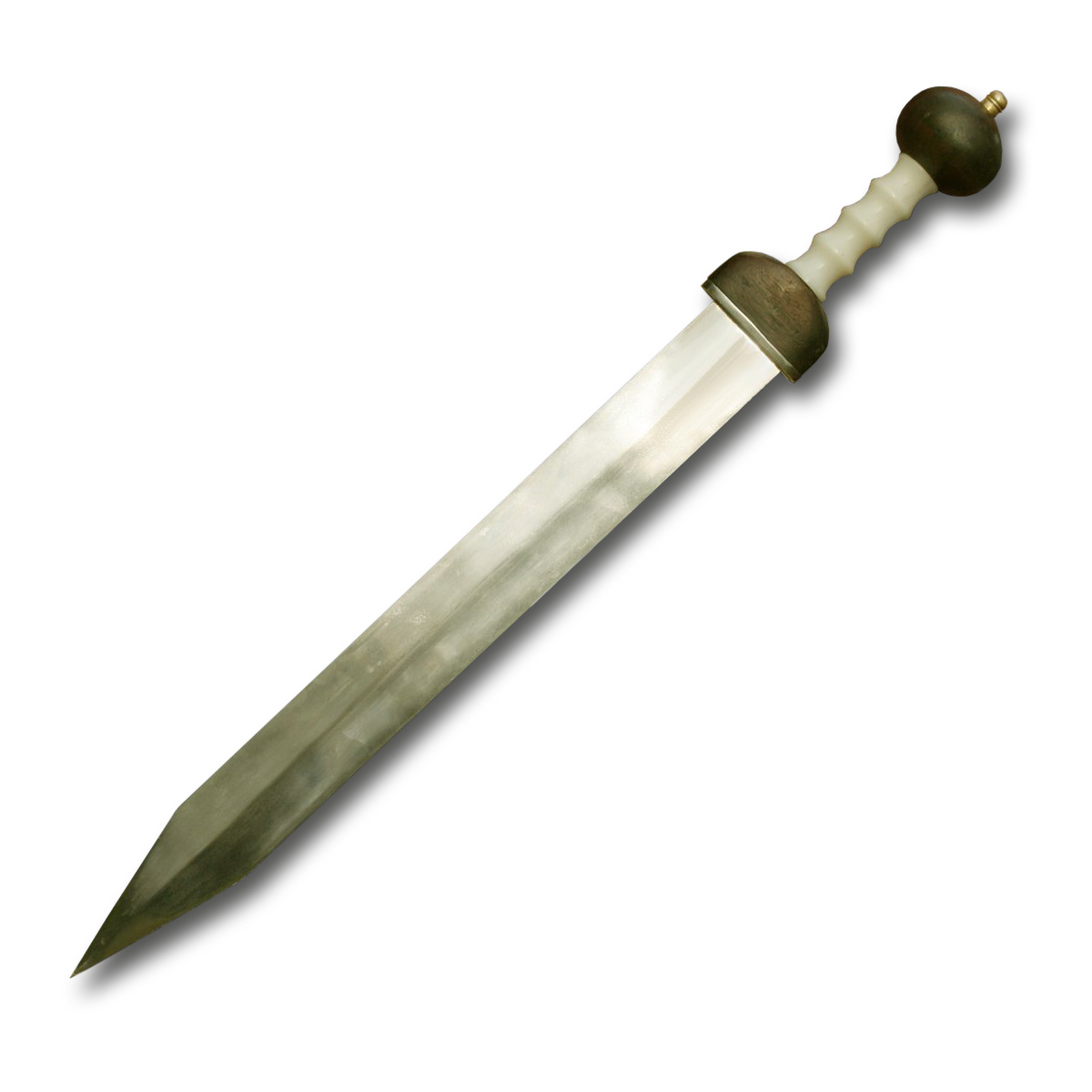 |
| Photo of a replica Gladius at Wikimedia Commons |
Perhaps no weapon was so effective for its time as the vicious Roman short sword- the Gladius. It is the origin of the word Gladiator- he who uses a sword. This weapon was so effective that a number of historians still attribute it to killing more people than any other weapon in history. This is likely a tall tale, but the weapon's effectiveness can also be attested by its long service life- for nearly 600 years a Gladius-type system was the standard infantry weapon of the Republican and Imperial soldiers of Rome.
Metallurgy:
Part of the reason the weapon was so effective, aside from the Roman legionary tactics that were proven superior over most fighting systems of the time at places like Cynosephalae and Pydna, was the composition of the weapon. It had a higher steel content than many weapons it faced off against. Do note though that the swords were not entirely steel, as the technology to make solid steel swords did not yet exist. Typically, a Roman short sword had a soft iron core and steel edges. Nevertheless, it was far superior to the iron or bronze weapons it often encountered.
Shape and Form:
The shape of the sword was another hefty advantage (especially when coupled with a classic legionary's other equipment, most notably the Scutum and Pilum). Livy writes as to the effectiveness of the Gladius against a typical Roman opponent- a Gallic warrior with a large sword and shield:
With a breast full of courage and silent wrath Manlius reserved all his ferocity for the actual moment of conflict. When they had taken their stand between the two armies, while so many hearts around them were in suspense between hope and fear, the Gaul, like a great overhanging mass, held out his shield on his left arm to meet his adversary's blows and aimed a tremendous cut downwards with his sword. The Roman evaded the blow, and pushing aside the bottom of the Gaul's shield with his own, he slipped under it close up to the Gaul, too near for him to get at him with his sword. Then turning the point of his blade upwards, he gave two rapid thrusts in succession and stabbed the Gaul in the belly and the groin, laying his enemy prostrate over a large extent of ground. He left the body of his fallen foe undespoiled with the exception of his chain, which though smeared with blood he placed round his own neck. Astonishment and fear kept the Gauls motionless; the Romans ran eagerly forward from their lines to meet their warrior, and amidst cheers and congratulations they conducted him to the Dictator. In the doggerel verses which they extemporised in his honour they called him Torquatus ("adorned with a chain"), and this soubriquet became for his posterity a proud family name. The Dictator gave him a golden crown, and before the whole army alluded to his victory in terms of the highest praise.- Livy, The History of Rome, Vol. II, 7.10
However accurate this story of champion warfare is, it highlights the maneuverability that the compact Gladius would have offered to a Roman soldier. Made primarily for stabbing (but not exclusively reliant on it, as many believe), the Gladius needed only a short, simple movement into the enemy to deliver a killing blow. While a heavier broadsword made its motions through the air for a hack or slash, a Roman legionary with his Gladius could deliver a short, simple, and far more lethal puncture wound to the enemy.
The Gladius truly was a short sword. At most it was only about two feet long. Unlike a Greek that fought primarily with a spear that could reach at minimum around eight feet (the Dory) and at maximum up to eighteen (the Sarissa), Roman combat was the definition of "up close and personal." It took incredible courage to do what the Roman legionary would have had to do. The Gladius itself was seemingly a call to courage.
Replacement:
However, as good as it was, not even the Gladius could last forever. Toward the end of the 3rd century it began to be replaced by a longer sword- the Spatha, a weapon that had always been the blade of the Roman cavalry. The movies and even documentaries you see of the Roman legionary brandishing his classical Gladius against the barbarian hordes in the latter days of Rome are untrue. His equipment had changed significantly by then. Perhaps it was due to the increasingly important role of cavalry in warfare, or due to the smaller size of the shield as the rectangular Scutum was replaced by an ovular shield and the Spatha was a better companion to it than the Gladius. It being a response to the increased conflicts with the Sassanid Persians, who were heavily reliant on cavalry seems plausible. A sword as short as the Gladius, after all, isn't exactly ideal for fighting a man on horseback.
Though its days as the primary weapon of the legionary were over, it stood the test of time. The M16 system, the primary armament of the U.S. military's infantry, is regarded as an extremely well-balanced weapon, one that has stayed true for the past half century. The Gladius lasted many times longer, a time span that testifies to its effectiveness on the battlefield.
See also:
An interesting discussion about the Gladius' replacement with the Spatha
Richard F. Burton- The Book of the Sword, ch. 13
Roman Military Equipment: Weapons Roman Republic Empire Weapons Gladius Short Sword
No comments:
Post a Comment